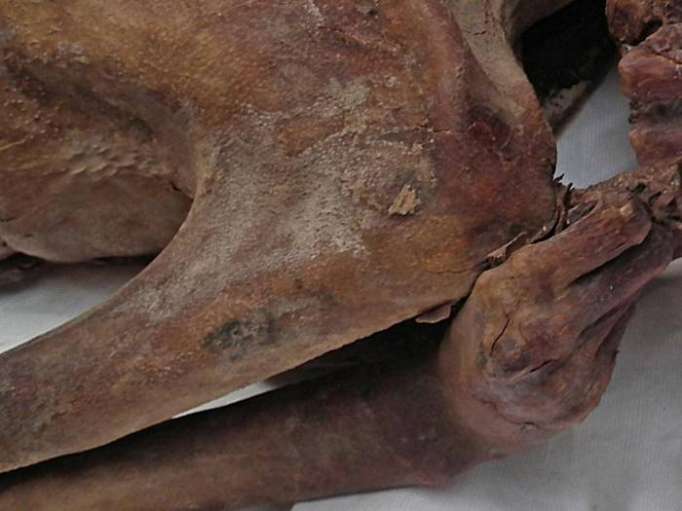Previously, all that academics and museum visitors alike had been able to see were faint, dark smudges on the man’s right arm. But recent infrared examination has revealed the marks are in fact tattoos depicting two animals – a giant wild bull and a wild North African goat-like creature.
It is likely the man wore his tattoos in order to help project an image of strength and macho virility. Throughout much of the ancient world, both types of animal were often associated with male power, virility, fertility and creation.
The two animals were tattooed onto the man’s arm some 5,200 years ago. Along with a Copper Age European of almost identical vintage, found preserved in an Alpine glacier, the ancient Egyptian is the oldest tattooed individual ever discovered.
However, the Alpine mummy – often dubbed the Iceman – only had seemingly abstract groups of dots tattooed on him. The Egyptian, on the other hand, bears the earliest known example of tattoos in figurative art form.
Examination of the art suggests they were made with a carbon-based pigment, probably soot.
The bull portrayed in the larger of the man’s two tattoos represented a now-extinct species of giant wild bull, known as the aurochs. They were feared, admired and often worshipped throughout parts of the ancient world.
They are likely to have been the origin of many of the great bull legends of antiquity – the story of the Cretan Minotaur, the Mesopotamian Bull of Heaven and the Anatolian bull-shaped God of Storms. In ancient Egyptian religion, there are three bull gods, each symbolising either fertility or war.
The other animal, a goat-like creature known as a Barbary sheep and portrayed in tattoo form on the British Museum ancient Egyptian, may likewise have been associated with male virility.
Throughout much of the ancient world, goat-like creatures were often associated with masculine sexuality. In Greece, they feature in mythology as often erotic Pan, god of the wild. In ancient Egypt, the ram was sometimes perceived as a primeval force linked to procreation. Indeed, there were three Egyptian sheep gods linked to fertility and creation.
The Egyptian with the bull and Barbary sheep tattoos lived at a time before fully developed hieroglyphic writing had come into existence – and there is therefore no written record of the beliefs of his time. But later Egyptian and other belief systems and mythologies are well-documented and almost certainly often had their roots in his era or even earlier.
New infrared examination revealed the tattoo 100 years after the mummy went on display at the British Museum (British Museum)
The British Museum scientists have also discovered a second ancient Egyptian individual with tattoos, dating from the same period. This second mummy, a woman, had more abstract designs – a series of small S-shaped marks on her right shoulder and a line with a slightly curved upper end on her right arm. The motif on her arm may represent a staff of office – a symbol of authority. She is by far the earliest woman in the world so far discovered with tattoo designs on her skin.
Both the man and the woman had been mummified naturally as a result of ultra-dry climatic conditions.
There are at least another 14 very early natural ancient Egyptian mummies in museums in Egypt, Canada and Italy – and it’s now likely that some of those will be examined with infrared imaging equipment in the hope of discovering more very early tattoos. Until the recent British Museum discoveries, the oldest known ancient Egyptian tattoo dated from around 2000 BC – some 1,200 years later than the ones just announced by the British Museum.
Just as in modern times, tattoos were a truly global phenomenon in the ancient world. Although the British Museum discoveries and the tattooed dots on the Alpine Iceman are the oldest known surviving tattoos, it is likely that the invention of tattooing occurred much much earlier in multiple locations across the globe.
There are some indications, from pottery figurines, that the art form may have been practised in Japan some 12,000 years ago. Certainly tattooing was known in China more than 4000 years ago – and in South America at least 1,500 years ago. There are also marks on 40,000-year-old Stone Age European figurines that could represent tattoos.
The British Museum’s newly discovered ancient Egyptian examples are therefore a fascinating addition to a very ancient worldwide artistic tradition.
The mummies were originally found more than 100 years ago in an ancient predynastic Egyptian cemetery at Gebelein in southern Egypt.
The newly discovered tattoos were published on Thursday in the Journal of Archaeological Science. Daniel Antoine, one of the lead authors of the research paper and the British Museum’s Curator of Physical Anthropology said: “The use of the latest scientific methods, including CT scanning, radiocarbon dating and infrared imaging, has transformed our understanding of the Gebelein mummies.
“Only now are we gaining new insights into the lives of these remarkably preserved individuals. Incredibly, at over five thousand years of age, they push back the evidence for tattooing in Africa by a millennium.”
The Independent
More about: Egypt
















































